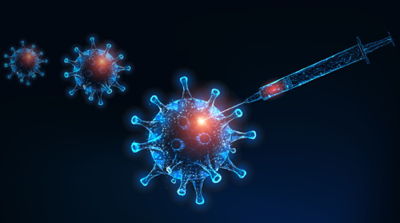An effective mRNA vaccine is characterized by high protein (= antigen) expression and low innate immunogenicity.
N1-Methylpseudouridine: Increase mRNA vaccine effectiveness
Nucleoside modifications can influence these characteristics as shown by the pioneering work of Kariko et al.[1-3]. In particular, N1-Methylpseudouridine-modified mRNA (Andries et al.[4]) showed remarkably enhanced protein expression combined with low immunogenicity in cell culture experiments[4,5].

The COVID-19 mRNA vaccines developed by Pfizer-BioNTech and Moderna demonstrate the excellent utility of N1-Methylpseudouridine-modification in mRNA vaccine development, whereby Uridine is fully replaced by N1-Methylpseudouridine in both mRNA vaccines[6-9]. Preparation of N1-Methylpseudouridine-modified RNA was performed by enzymatic incorporation of the corresponding triphosphate N1-Methylpseudo-UTP via T7 RNA polymerase-mediated in vitro transcription.
Our N1-Methylpseudo-UTP product portfolio:
mRNA Production (mL to multi-liter scale):
| Cat No | Product Name | Specifications |
| NU-890-THR | N1-Methylpseudo-UTP, Sodium salt | Purity (HPLC): >/= 99 % Identity (MS): conforms (positive and/or negative mode) Concentration (UV/Vis): 100 – 105 mM pH: 7.5 +/- 0.25Additional tests: Functionality (T7 IVT), DNAse & RNAse contamination (FRET), Protease contamination (UV-Vis) and Endotoxin (LAL test) Animal-origin free starting materials & production |
Research & Development:
| Cat No | Product Name | Specifications |
| NU-890-S/L | N1-Methylpseudo-UTP, Sodium salt |
Purity (HPLC): >/= 95 % Identity (MS): conforms (positive and/or negative mode) Concentration: 100 – 110 mM pH: 7.5 +/- 0.5 |
| RNT-107-S/L | HighYield T7 mRNA Synthesis Kit (me1Ψ-UTP) |
Production of 100 – 130 µg uncapped, N1-Methylpseudouridine-modified RNA* |
| RNT-115-S/L | HighYield T7 ARCA mRNA Synthesis Kit (me1Ψ-UTP) |
Production of 30 – 50 µg ARCA-capped, N1-Methylpseudouridine-modified RNA* |
* Standard reaction: 1 µg T7 DNA control template, 1400 nt RNA transcript, 30 min incubation at 37 °C.
Selected References:
[1] Karikó et al. (2005) Suppression of RNA Recognition by Toll-like Receptors: The Impact of Nucleoside Modification and the Evolutionary Origin of RNA. Immunity 23 (2):165.
[2] Karikó et al. (2008) Incorporation of Pseudouridine yields superior nonimmunogenic vector with increased translational capacity and biological stability. Molecular Therapy 16 (11):1833.
[3] Anderson et al. (2011) Nucleoside modifications in RNA limit activation of 2’-5’-oligoadenylate synthetase and increase resistance to cleavage by RNase L. Nucleic Acids Research 39 (21):9329.
[4] Andries et al. (2015) N1-Methylpseudouridine-incorporated mRNA outperforms pseudouridine-incorporated mRNA by providing enhanced protein expression and reduced immunogenicity in mammalian cell lines and mice. J. Controlled Release 217:337.
[5] Svitkin et al. (2017) N1-methyl-pseudouridine in mRNA Enhances Translation through eIFalpha-dependent and Independent Mechanism by Increasing Ribosome Density. Nucleic Acids Res. 45:6023.
[6] Morais et al. (2021) The Critical Contribution of Pseudourdine to mRNA COVID-19 Vaccines. Frontiers in Cell and Developmental Biology 9:1.
[7] Nance et al. (2021) Modifications in an Emergency: The Role of N1-Methylpseudouridine in COVID-19 vaccines. ACS Cent. Sci. 7 (5):748.
[8] Chaudhary et al. (2021) mRNA vaccines for infectious diseases: principles, delivery and clinical translation. Nature Reviews Drug Discovery 20:817.
[9] Dolgin (2021) CureVac COVID Vaccine Let-Down Spotlights mRNA Design Challenges. Nature 594:483.
